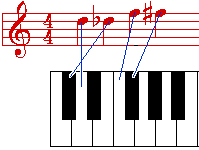Now that individuals’ve established that music consists of sounds I will explain such a sound turns out to be:
All sounds are generated by the vibrations of air molecules. These waves (“sound waves”) of vibrations in air molecules are derived from some kind of vibrating object, maybe a musical instrument or maybe a person’s vocal chords. In music we make reference to the frequency (present the molecules vibrate per second) a communication vibrates at because pitch in the note.
In modern sheet music you’ll see the music will likely be written on either the treble clef staff:
![]()
As the notes are written better the top of these clefs there pitch increases going for a higher, lighter sound. Conversely, as notes are written more detailed the bottom in the clefs the pitch decreases going for a lower, darker sound. The treble clef contains notes which can be higher in pitch versus the bass clef as well as the bass clef contains notes that happen to be lower in pitch versus the treble clef. For this reason for a lot of instruments which have a wide range of notes, the piano particularly, chances are you’ll see these staffs combined as follows:

The next image may help you visualize how notes are positioned on the staffs in terms of their pitch. It is a picture of your piano keyboard using the clefs and notes written over top:

Notice that as you go through the lower pitch notes for the left in the piano on the higher pitch notes within the right side from the piano the notes are written for the staffs in ascending order. As you can see from your diagram above we quite often write notes that happen to be below or over the lines for the staff, these notes display on extra small lines called ledger lines. You may also discover that there is one note (middle C) that is written as both ledger line on top of the bass clef or jointly ledger line below the treble clef. The diagram above shows all on the white notes within the piano written around the staffs, but you’re probably thinking about the black notes, how is he or she written? Well, this is answered by viewing the diagram below:

In music you’ll find notes that we occassionally come across called “Accidentals”. So what exactly are these accidentals, you could possibly be asking, the notes I accidentally abide by mistake? No, even though some musicians might try to use that just as one excuse, accidentals are in reality notes which are called for you to definitely play in the piece of music which are not within the general key that most in the song is printed in.
When you encounter some text in music that features a b to your left of the usb ports you have fun playing the note immediately left of it for the keyboard. If you encounter some text that has a # in front than it you participate in the note immediately towards the right of it about the keyboard.
